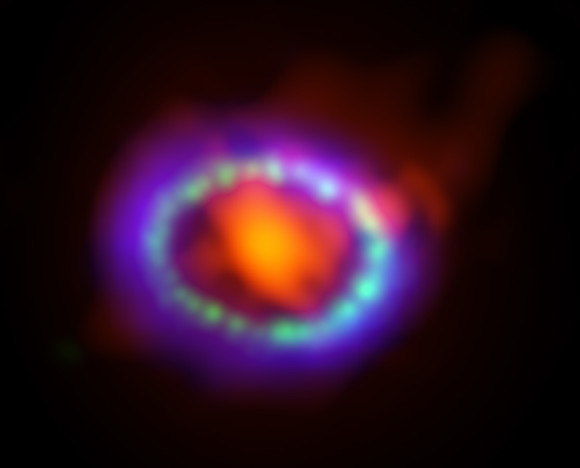An international team of astronomers used the Atacama Large Millimeter/submillimeter Array (ALMA) telescope to capture, for the first time, the remains of a recent supernova brimming with freshly formed dust. The team is reporting on the findings this week (January 5-9, 2014) at the 223rd meeting of the American Astronomical Society in Washington D.C.


Galaxies can be remarkably dusty places and astronomers think that supernovas are a primary source of that dust, especially in the early universe. But so far, there hasn’t been much direct evidence of a supernova’s dust-making capabilities.
The astronomers used ALMA to observe the glowing remains of supernova 1987A, which is in the Large Magellanic Cloud, a dwarf galaxy orbiting the Milky Way approximately 168,000 light-years from Earth. Light from this supernova arrived at Earth in 1987, inspiring its name.
Astronomers have predicted that as the gas cooled after a supernova explosion, large amounts of molecules and dust would form as atoms of oxygen, carbon, and silicon bonded together in the cold central regions of the remnant. However, earlier observations of 1987A with infrared telescopes, made within the first 500 days after the explosion, detected only a small amount hot dust.
With the ALMA telescope’s resolution and sensitivity, the research team was able to image the far more abundant cold dust. The astronomers estimate that the remnant now contains about 25 percent the mass of our sun in newly formed dust. Remy Indebetouw is an astronomer with the National Radio Astronomy Observatory (NRAO) and the University of Virginia. He said:
1987A is a special place since it hasn’t mixed with the surrounding environment, so what we see there was made there. The new ALMA results, which are the first of their kind, reveal a supernova remnant chock full of material that simply did not exist a few decades ago.
Read more about this work from the National Radio Astronomy Observatory (NRAO)
Read more from this week’s AAS meeting:
Triple millisecond pulsar reveals secrets of gravity











